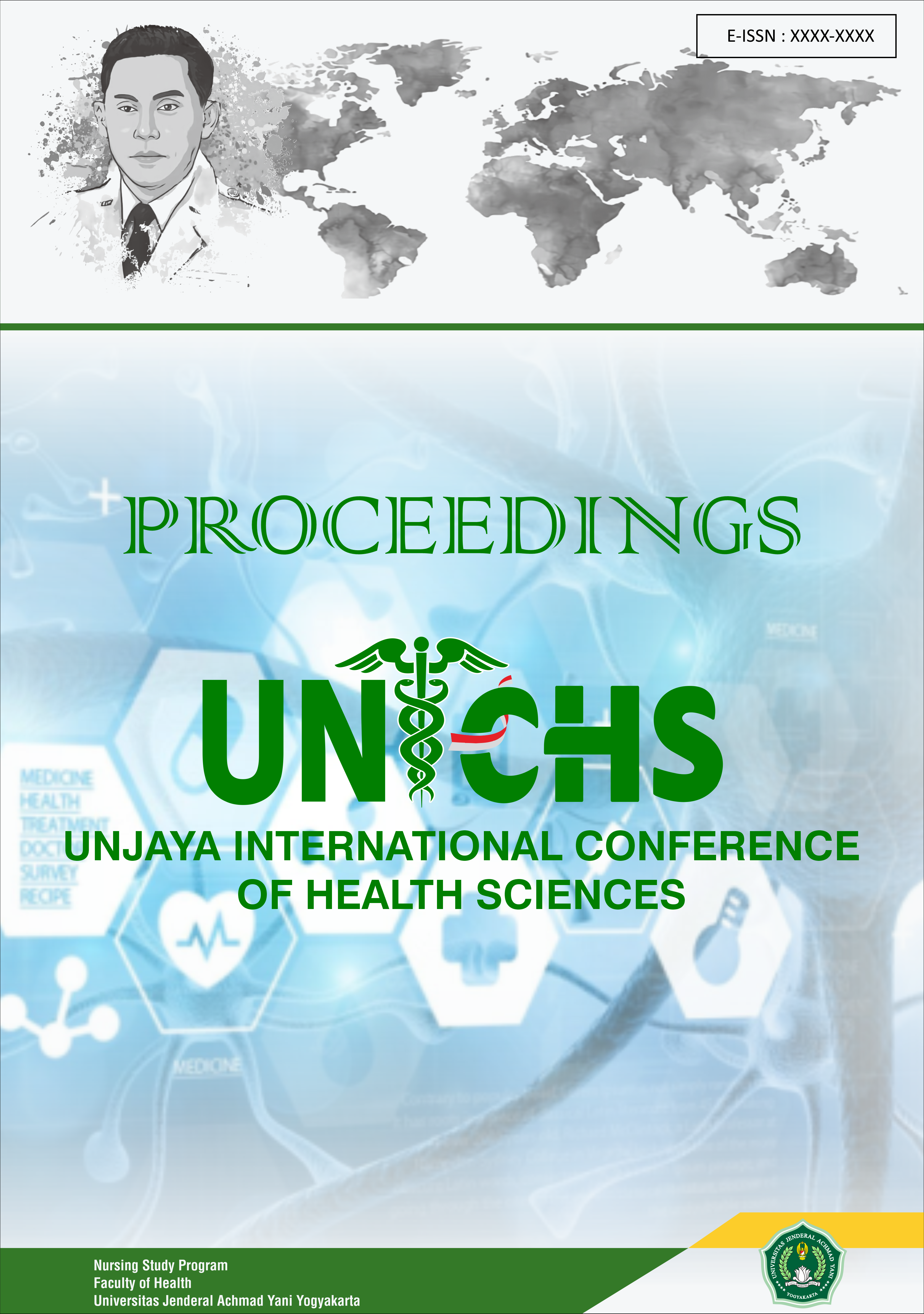The Correlation of Environmental Sanitation and Diarrhoea Prevalence in Toddlers at Puskesmas Bantul I
Keywords:
Diarrhoea, Environment sanitation, ToddlersAbstract
Background: Diarrhea remains the second leading cause of death in toddlers. The causes of diarrhea in toddlers are diverse, including poor environmental sanitation. Poor sanitation that leads to diarrhea includes the lack of clean water facilities, high population density, unavailability of toilets, and other factors that cause environmental pollution.
Purpose: It aims to determine the correlation between environmental sanitation and diarrhoea prevalence in toddlers in Puskesmas Bantul 1.
Methods: The research was descriptive-analytic using a cross-sectional design. The population was 981 toddlers counted from the data from January until March 2024, and the sample was 98 respondents was purposive sampling. The research was conducted in Puskesmas Bantul 1 area from February until July 2024. The data analysis of bivariate used lambda symmetric. Data collection tools used environmental sanitation questionnaires and diarrhea incidence questionnaires.
Results: From the 98 respondents, the highest category of environment sanitation was the qualified as many as 75.5% and the unqualified as many as 24.5%. The most diarrhoea prevalence was 54.1% and non-diarrhoea was 45.9%. The result of the lambda symmetric test was a p-value of <0,001.
Conclusion: There was a strong correlation between environmental sanitation and diarrhoea prevalence in toddlers in Puskesmas Bantul 1. It is hoped that people can pay attention to the provision of clean water sources at least for daily usage and consumption.
References
Adrian. M. (2021). Pedoman sanitasi lingkungan. Yogyakarta:Diva press. Cet-1. ISBN 978-623-293-484-9
Akhondi, Hossein ; Kari A.Simonsen. (2023). Bacterial Diarrhea. StatPearls. Link: https://www.ncbi.nlm.nih.gov/books/NBK551643/
Anggi Kurnia Adha Harahap. (2021). Jurnal Kesehatan. Hubungan Sanitasi Lingkungan dengan Kejadian Diare Dirantauprapat. Fakultas ilmu Kesehatan Masyarakat Universitas Islam Negeri Sumatera Utara. Ditinjau tanggal 09 Oktober 2023. https://ejournal.unaja.ac.id/index.php/JKKM/article/download/1116/817/
Badan Pusat Statistik. (2022). Statistik Indonesia 2022. Jakarta: Badan Pusat Statistik
Badan Perencanaan Pembangunan Nasional. (2021). SDGs Dashboard Indonesia. https://sdgs.bappenas.go.id/website/wp-content/uploads/2023/02/LAPORAN-PELAKSANAAN-SDGS-2021.pdf
Badan Pusat Statistik (2023). Persentase Rumah Tangga menurut Provinsi, Tipe Daerah dan Sanitasi Layak (Persen), 2021-2023. Link https://www.bps.go.id/id/statistics-table/2/ODM0IzI=/persentase-rumah-tangga-menurut-provinsi--tipe-daerah-dan-sanitasi-layak.html
Badan Kependudukan Keluarga Berencana Nasional. (2022). Sanitasi Lingkungan. Artikel. link: https://kampungkb.bkkbn.go.id/kampung/14028/intervensi/415070/sanitasi-lingkungan
Basyariyah, Q., Khuliyah, C.D, Aditya, S.P. (2022). Hubungan Ketersediaan Sanitasi Dasar terhadap kejadian diare. Jurnal Kesehatan Lingkungan Indonesia 21(1) Tahun 2022.
Birawida, A. B. (2020). Sanitasi dan keberadaan bakteri pada air minum dengan risiko diare di Pulau Barrang Lompo. Jurnal Nasional Ilmu Kesehatan, 3(1), 1-13.
Dahlan, M. S. (2016). Statistik Untuk Kedokteran dan Kesehatan. Jakarta : Salemba Medika.
Damayanti, I. P. (2017). Hubungan Ketersediaan Air Bersih dengan Kejadian Diare pada Balita. Menara Ilmu, XI(78), 48–52.
Deva Santika, Basri Aramico dan Farrah Fahdhienie. (2022). Kejadian Diare Di wilayah Kerja Puskesmas Meggamat Kecamatan Kluet Tengah Kabupaten Aceh Selatan Tahun 2022. Jurnal Hubungan Sanitasi Lingkungan. vol. 1, no. 1. https://ejournal.unaja.ac.id/index.php/JKKM/article/download/1116/817/
Dinas kesehatan DIY. Profil Kesehatan Provinsi DI Yogyakarta. Yogyakarta : Dinas Kesehatan Yogyakarta; 2022
Direktorat Jenderal Pencegahan dan Pengendalian Penyakit, (2023) Kemenkes RI.
EPA. (2021). United States Environmental Protection Agency. Impacts of Mismanaged Trash
Garret J, Descoteaux-Friday & Isha Shrimanker. (2023). Chronic Diarrea. Statpearls. https://www.ncbi.nlm.nih.gov/books/NBK544337/
Indonesia Times Jogja. (2023) Ribuan KK di Bantul Belum Memiliki Jamban Sehat link: https://jogja.idntimes.com/news/jogja/hironymus-daruwaskita/ribuan-kk-di-bantul-belum-memiliki-jamban-sehat-c1c2.
Kementrian Kesehatan. (2023). Diare. Ayo sehat. Link: https://ayosehat.kemkes.go.id/topik-penyakit/penyakit-pencernaan/diare
Kementerian Kesehatan RI. (2014). Peraturan Menteri Kesehatan Nomor 3 Tahun 2014 tentang Sanitasi Total Berbasis Masyarakat. Jakarta: Kementerian Kesehatan RI.
Kementerian Kesehatan RI. 2023. Profil kesehatan Indonesia. Jakarta: Kementerian Kesehatan RI.
National Water And Sanitation Informasi Service (NAWASIS). (2020). Database berdasarkan SDGs. https://www.nawasis.org/portal/database/home/definisi
Nemeth, Valerie & Nicholas Pflehaar . (2022). Diarrhea. StatPearls. Link: https://www.ncbi.nlm.nih.gov/books/NBK448082/#_ncbi_dlg_citbx_NBK448082
Notoatmodjo, S. (2018). Metodologi Penelitian Kesehatan (3rd ed.). Jakarta: Rienka Cipta.
Peraturan Menteri Lingkungan Hidup dan Kehutanan Republik Indonesia Nomor 6 Tahun 2022 Tentang Sistem Informasi Pengelolaan Sampah Nasional
Rahman, A., Fea, F., Defriman, D., Nur, I.R.A. (2021). Faktor-Faktor yang Mempengaruhi Sanitasi Lingkungan di Rural Area dan Urban Area di Provinsi Sumatera Barat 2020. Jurnal Keselamatan, Kesehatan Kerja dan Lingkungan (JK3L). Vol .02, No. 02.
Roflin, E. (2021). Pengelolaan dan Penyajian Data Penelitian Bidang Kedokteran. Nasya Expanding Manajemen.
Santika, Deva. (2022). Hubungan Sanitasi Lingkungan Dengan Kejadian Diare pada Balita di Wilayah Kerja Puskesmas Menggamat Kecamatan Kluet Tengah Kabupaten Aceh Selatan Tahun 2022. Jurnal Sains Riset (JSR) p-ISSN 2088-0952, e-ISSN 2714-531X http://journal.unigha.ac.id/index.php/JSR DOI. 10.47647/jsr.v10i12
Sedata Sebantul. (2023). Jumlah Kasus Penyakit Diare di Wilayah Kerja Puskesmas Kapanewon. Link: https://demo5.kab-bantul.id/search/detail?data_id=1.02.0274&ryear=2021%20-%202023
Siregar, S. I. (2013). Statistik Parametri Untuk Penelitian Kuantutatif. Jakarta: Pt Bumi Askara.
Siregar, Yuni Harmila. (2021). Hubungan Sanitasi Lingkungan Terhadap Kejadian Diare Pada Balita di Wilayah Kerja Puskesmas Belongkut. Skripsi. Fakultas Kesehatan Masyarakat Universitas Islam Negeri Sumatera Utara. Link: http://repository.uinsu.ac.id/13703/1/SKRIPSI%20YUNI%20HARMILA%20SIREGAR%200801172221.pdf
Sugiyono. (2019). Metode Penelitian Kuantitatif Kualitatif dan R& D. Alfabeta.
UNICEF. (2024). Diarrhoea remains a leading killer of young children, despite the availability of a simple treatment solution. New York. 2024 link: https://data.unicef.org/topic/child-health/diarrhoeal-disease/
Wahyuni, Candra (2018). PANDUAN LENGKAP TUMBUH KEMBANG ANAK USIA 0 – 5 TAHUN. Jawa timur. Strada press. ISBN : 978-602-5842-08-5.
Wahyuni, NS (2022). Tumbuh kembang anak. Artikel. Kemenkes RI. https://yankes.kemkes.go.id/view_artikel/1669/tumbuh-kembang-anak
World Health Organization (2024). Diarrhoeal Disease link : https://www.who.int/news-room/fact-sheets/detail/diarrhoeal-disease






